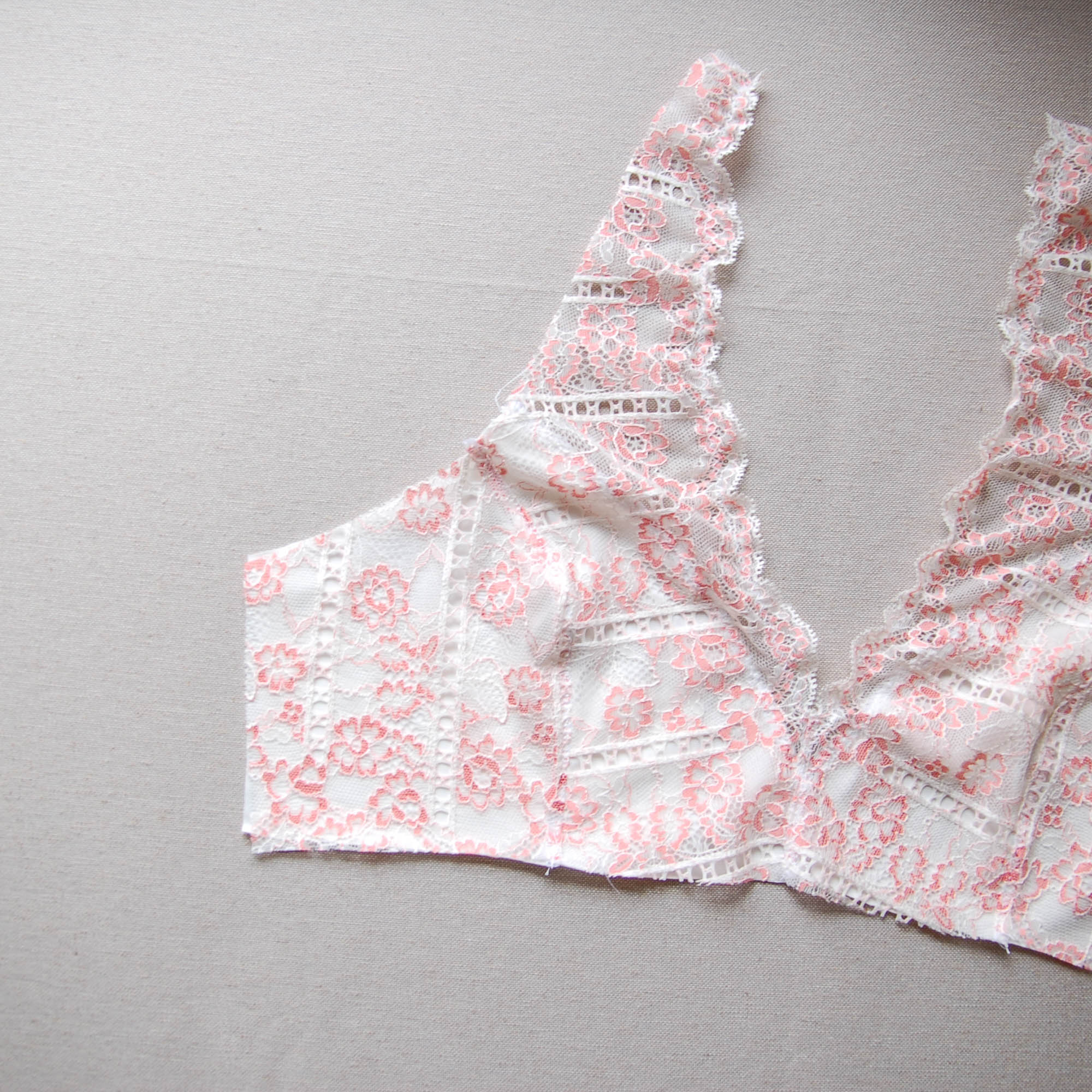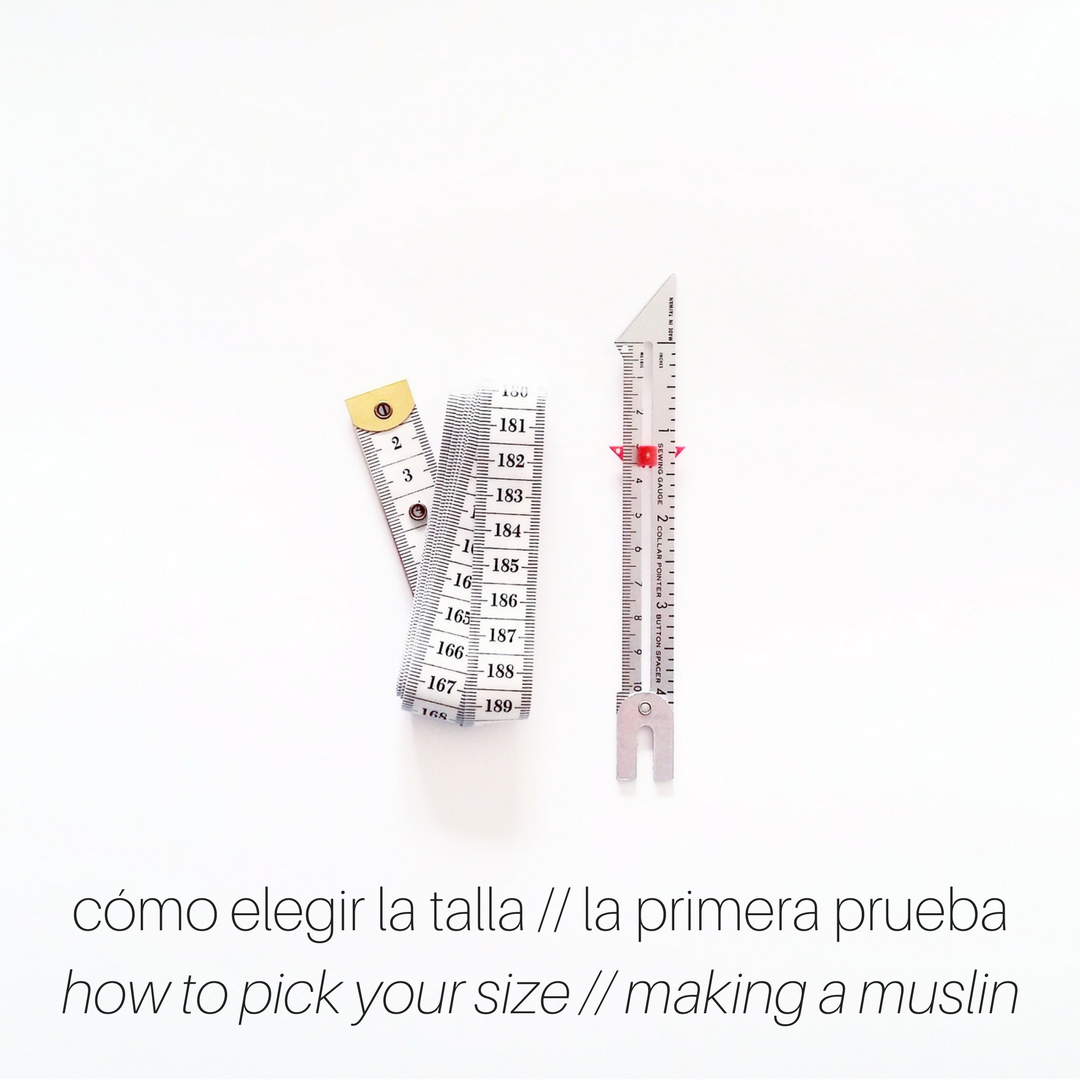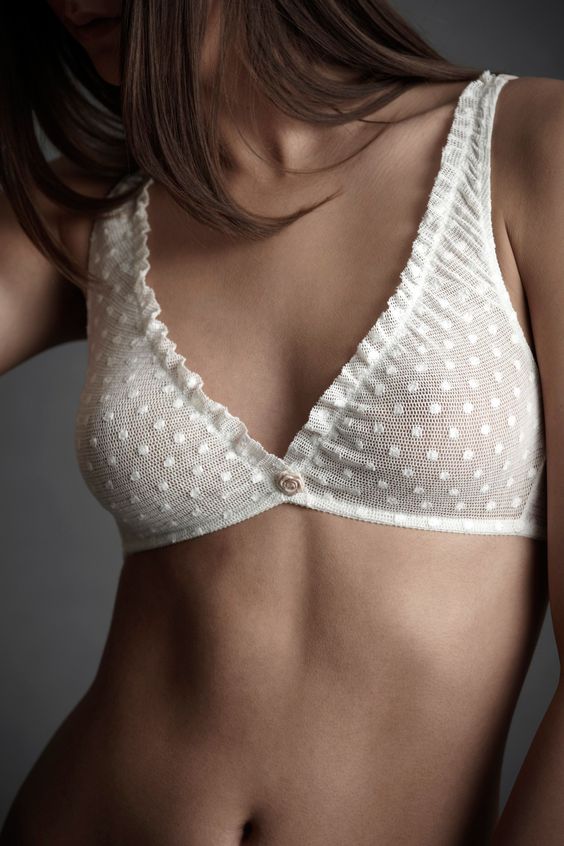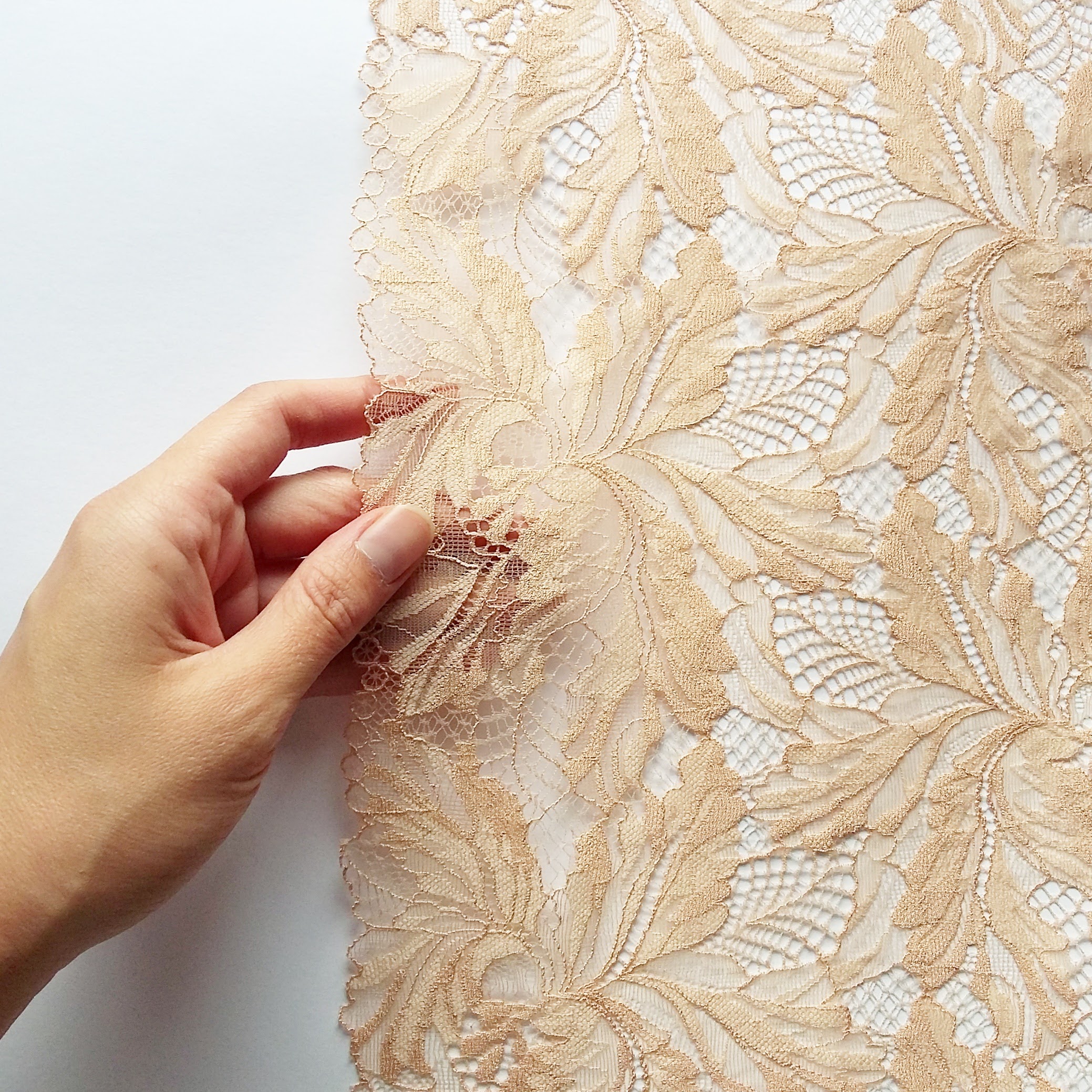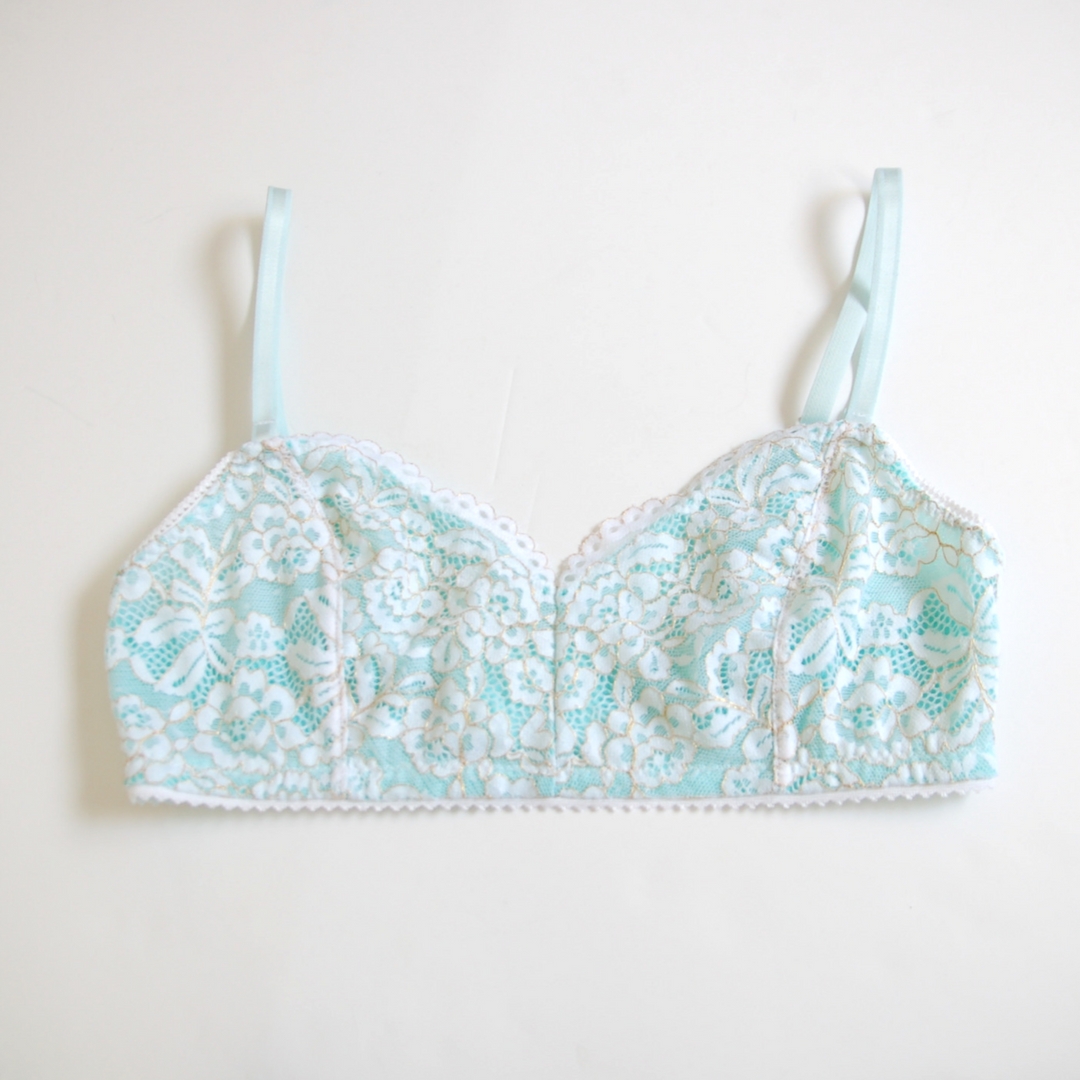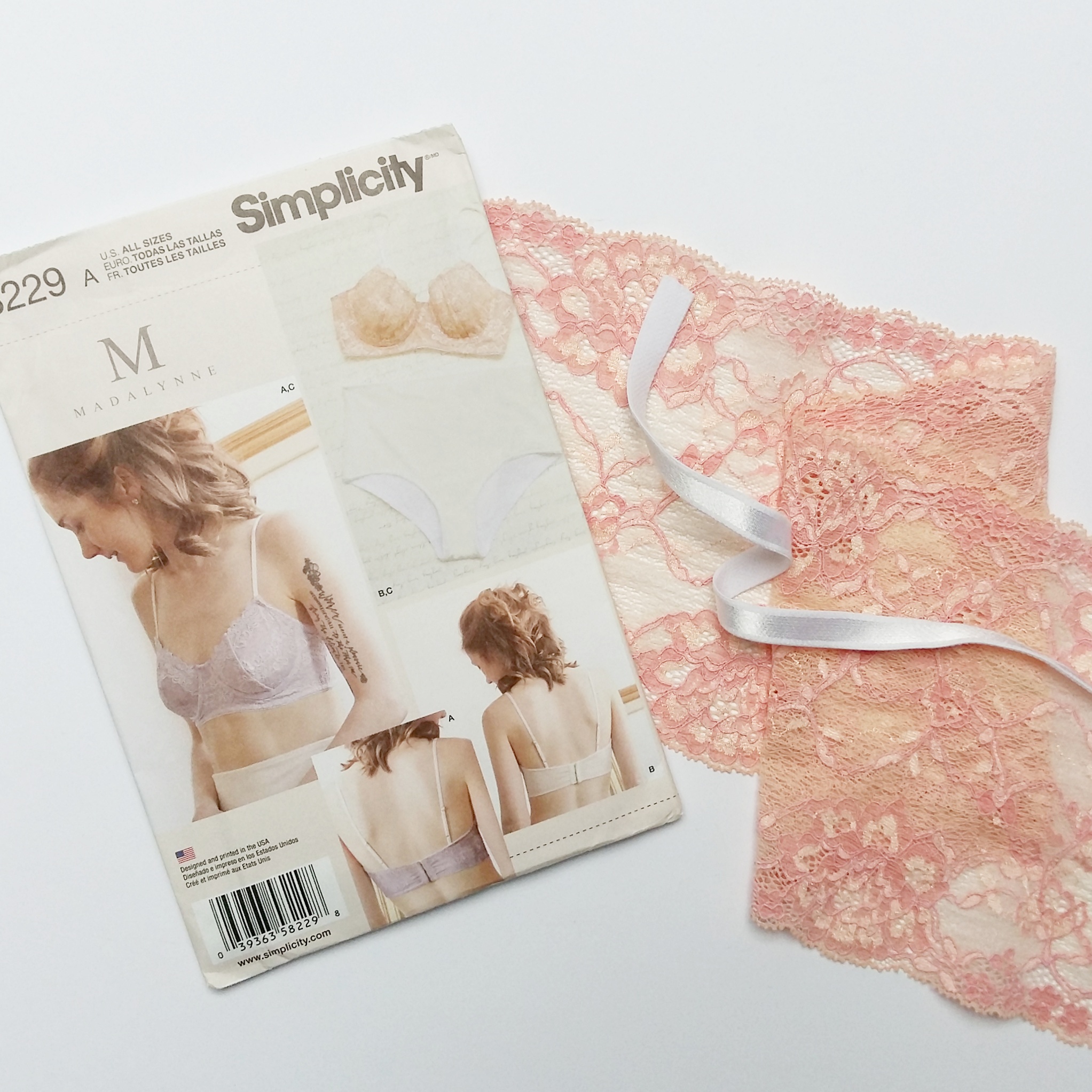Hola! Seguimos cosiendo el bralette Hanna. Las copas ya están montadas y ahora falta enganchar el forro de la copa interior (D) a la pieza de encaje de la copa interior (A).
Hey! We'll continue sewing the Hanna bralette. The cups are already sewn together and now we need to join the inner cup lining piece (D) to the inner cup lace piece (A).
Para poder hacerlo vamos a sujetar la pieza de forro (D) con los alfileres en su sitio. Estírala bien para que esté plana y que no queden arrugas. Sujeta con alfileres y cose con un zig-zag (2 de ancho, 3 de largo) justo encima del borde que rematamos anteriormente en el lado del forro. Yo suelo empezar en un lado, coser una copa, llego justo a la costura central y allí sigo hacia la otra copa.
To sew it correctly we need to pin the lining (D) in place. Align the lining piece so it will be flat and without wrinkles. Pin and sew with a zig-zag stitch (2 width, 3 length) exactly on top of the edge that we overlocked/zig-zag stitched in the beginning. I usually start in one end, sew until the center seam, pivot and sew the other part.
Es importante que cuadren las costuras centrales y que el forro se queda justo debajo de donde se acaba el encaje, de esa manera no tapamos el borde bonito de puntilla que queda en el escote.
It's important to align the center seams on both lining and lace layers. The lining willl lay exactly below the lace part, this way we will not cover the beautiful scalloped edge of the lace on the neckline.
Ahora es el momento de juntar las piezas de la banda a las copas exteriores. Se hace de la manera similar como cuando unimos las piezas de copa entre sí. Coloca las piezas unas encima de las otras en el siguiente orden: forro de la banda (C) con el derecho hacia arriba, la copa de encaje con el derecho hacia arriba (con todas sus piezas ya unidas de la manera que el encaje se queda con el derecho hacia arriba y el forro de la copa se queda con el derecho hacia abajo) y banda de encaje (C) con el revés hacia arriba. De nuevo tienes cuatro capas unas encima de las otras. Básicamente las piezas de la copa están como en el sandwitch entre el forro de la banda y la pieza de la banda de encaje.
Now it's time to join the band pieces with the cups. This is done in a same way as we did when joining the cup pieces. Put the pieces on top of each other in the following order: band lining (C) with right side up, the outer cup lace piece with the right side up (with all its pieces together, the lining will be with the right side down and the lace will be with the right side up) and the lace band (C) with the wrong side up. Again you have four layers on top of each other. The cup pieces are sandwitched between the band pieces.
Esta vez la costura es más sencilla porque se trata de una línea recta. Remalla o cose un zig-zag (2 de ancho, 3 de largo) a 6 mm del borde uniendo las cuatro capas. Coloca las piezas en su sitio y ves que de nuevo está todo limpio tanto por fuera como por dentro.
This time sewing is easier as it's a straight line. Overlock or zig-zag stitch (2 width, 3 length) with a 6 mm seam allowance joining the four layers. Put the pieces back to their place and you'll see a neat finish both on the outside and on the inside.
Yo en este punto no suelo hacer el pespunte encima de esta costura como en las copas pero si lo prefieres lo puedes hacer. Repite con el mismo lado. Y ya están todas las piezas unidas entre sí, ahora vamos con los elásticos!
I don't usually do the topstitching here like we did on the cup seam but if you'd like you can do it. Repeat with the other side. Now when all the pieces are together we'll sew on the elastics!
En este punto vamos a empezar con la parte debajo del pecho y allí es donde vamos a poner primero el elástico de lencería. Sobre este tema siempre tengo muchas preguntas, voy a intentar explicaros como pueda para que quede claro (también tengo un post sobre cómo coser los elásticos de lencería si quieres más información). Se cose en dos vueltas, primero en el derecho del bralette y luego se dobla hacia el revés y se vuelve a coser.
Coloca tu bralette con el derecho hacia arriba (con el encaje hacia ti) y pon el elástico encima de la parte debajo del pecho de la manera que el lado suave del elástico se quede hacia ti y la orilla decorativa se quede hacia dentro del bralette. Alineamos el elástico con el borde y vamos a coserlo a lo largo de todo el bajo.
We're going to start with the band part of the bralette for the first elastic. I always have lots of questions about inserting elastics, I'll try my best to explain it the easiest way possible (I also wrote a post about sewing lingerie elastics it if you want to read more). The elastic is sewn in two rows, first on the right side of the bralette and then it's folded on the reverse and stitched again.
Put your bralette with the right side up (with the lace part up) and put the elastic on top of the band in the lower part. The plush side is up and the decorative edge is towards the inside of the bralette. Align the elastic with the border, we'll sew it along all the underbust area.
Usando un zig-zag (2.5 ancho, 2.5 largo) cose cerca del borde decorativo del elástico mientras estiras ligeramente del elástico. Ligeramente significa que queremos que el elástico tenga tensión (sino no va a sujetar) pero que no apriete demasiado. En el caso ideal se forma un ligero frunce en el revés, así sabemos que el elástico tiene la tensión correcta. No estires el bralette, sólo estira el elástico.
Cuánto tirar? No quería poner en las instrucciones medidas exactas de elástico para cada talla porque según mi experiencia en vender los elásticos sé que no todos son igual de firmes. Un elástico más firme lo tienes que estirar un poco menos, un elástico más flojito pues al revés, tienes que tirar más para que sujete. Mi recomendación general es tirar 1 cm por cada 5 cm de elástico y observar después de coser un poco si en el revés parece que has tirado lo suficiente o no. Al principio cuesta hacer las dos cosas a la vez: tienes que coser recto y cerca del borde y encima estirar y no sabes ni cuánto... Viene con práctica, no te desesperes. Dentro de poco lo tienes "en la mano" y ya no piensas en los centímetros.
Es importante que mantengas el zig-zag cerca del borde en una distancia uniforme porque en el siguiente paso le damos la vuelta al elástico y allí es cuando se ve la puntilla (u otro tipo de borde decorativo).
Yo prefiero coser el elástico de esa manera, tirando mientras coso, porque también así aprovecho más los materiales, corto justo donde acabo. Si aún así eres de estas personas que necesitan medidas te recomiendo probar este cálculo: mide el bajo de tu bralette y multiplica ese número con 0.8. Corta este largo de elástico y divídelo en cuatro partes iguales al lo largo del mismo. Luego divide el bajo del bralette también en cuatro partes iguales y coloca el elástico juntando los puntos en el bajo y en el elástico. De esa manera (que es similar como poner los cuellos en prendas de punto por ejemplo) consigues que el elástico esté igualmente tensado en todo el largo del bajo del bralette. Ahora, ojo, lo de multiplicar con 0.8 es en un caso general, si resulta que tu elástico es más firme/más flojo, habrá que ajustarlo.
En fin, prueba y ve qué tal. Ya sé que eso no suena nada bien, pero siempre puedes descoser y volver a empezar (aunque reconozco que descoser el elástico de lencería es un rollo, jaja).
Using a zig-zag stitch (2.5 width, 2.5 length) sew close to the decorative edge of the elastic while you pull the elastic slightly. Slightly means that we want the elastic to have tension (otherways it won't give support) but we don't want it to pull too much. In a perfect case it will form a slight gathering on the wrong side of the bralette, that way we know that the tension of the elastic is correct. Don't stretch the bralette, only stretch the elastic.
How much should I pull? I didn't want to put the exact measurements on the instructions of this pattern as my experience when selling lingerie elastics is that all of them have a different firmness. There are stiffer ones you need to pull less and there are softer ones that need to be pulled a bit more. My general recommendation is to pull 1 cm for every 5 cm of the elastic and observe on the wrong side of the bralette if the tension feels right. In the beginning this step seems to be complicated: you need to sew straight and close to the edge while at the same time pulling the elastic and not knowing exactly how much to do it... It really comes with practice, don't feel overwhelmed. In no time you'll have it "in your hand" and you won't obsess with the centimeters.
It's important to maintain the same distance when doing the zig-zag stitching close to the decorative edge of the elastic. On the next step we'll fold the elastic on the wrog side and here you'll see the little decorative edge of the elastic.
I prefer sewing the elastic that way, pulling while I sew as this way I'll save elastic as I cut it exactly where I finish sewing. If you are one of those people who really needs the concrete measurements I suggest this calculation: measure the band edge of your bralette and multiply it with 0.8. Cut this length of elastic and divide it in four equal parts. Now divide the band edge in four equal parts too and pin the same points together on both the band and the elastic. With this method (same as sewing a knit neckband for example) you'll have the same tension in all of the band piece. Still you need to be careful as 0.8 is a general number, if your elastic is firmer/softer you still need to make adjustments.
You just have to try and see how it goes. I know it doesn't sound good but you can always unpick and start again (altough I have to recognize that unpicking zig-zag on lingerie elastics is horrible, hehe).
Ahora da la veulta a tu trabajo y recorta toda la tela en el margen de elástico que sobra hacia fuera. La idea es que vamos a doblar el elástico hacia el revés y no queremos que se vea el borde de la tela una vez que lo hacemos. Con cuidado metiendo la tijera entre la tela y el elástico, recorta al ras del zig-zag todo lo que sobra. Este paso también va a eliminar el bulto que vas a tener una vez que doblas el elástico. Hasta hace muy poco lo hice con tijeras normales y todo bien pero ahora que tengo las tijeras de aplicación (o de pico de pato) de Seoane Textil la verdad es que es mucho más fácil. Si haces mucho este tipo de costuras te las recomiendo, son muy cómodas!
Now turn your bralette around and on the reverse side cut away the fabric that extends from the zig-zag stitching. We'll be folding the elastic down on the wrong side so you don't want the seam allowance to peek out once you sew the elastic on. You need to carefully cut the fabric while not cutting the elastic, slipping the scissors between the two layers. This step also eliminates the extra bulk that you'll have when you fold the elastic. Until just recently I did cut with the regular scissors but now I have the duckbill (also called applique) scissors from Seoane Textil and it's so much more easier. If you do sew lot's of projects like this I can recommend them, they are very comfortable to use!
Una vez que tenemos la primera vuelta de elástico cosido vamos a ir con la segunda. Pero antes vamos a preparar los tirantes porque vamos a aprovechar esa segunda costura para colocarlos ya en su sitio.
Corta dos tiras de elástico de tirante, cada una 35 cm de largo. Con el derecho del tirante hacia arriba, pasa el tirante a través del regulador. Dobla la punta de tirante unos 1.5 cm hacia el revés y haz un remate en el revés del tirante con puntada recta (2.5 de largo).
Once we have the first pass of elastic done we'll sew the second one. But before we'll prepare the straps to be able to sew them in place while we are at it.
Cut two 35 cm long strips of strap elastic. With the right side of the elastic up pass the elastic trough the slider. Fold the ending down for aprox 1.5 cm on the wrong side and backstitch (2.5 length straigth stitch) on the wrong side of the elastic.
Pasa la arandela por la punta libre del tirante. Con el revés del tirante hacia arriba pasa la punta libre de nuevo por el regulador de la misma manera que en el primer paso.
Pass the elastic trough the ring. With the wrong side of the elastic up pass the free end of the elastic trough the slider like we did on the first step.
Y ya tienes un tirante regulable. Vuelve a repetir con el otro tirante.
Now you have a regulable strap. Repeat with the other strap.
En la pieza de la banda (C) tienes dos piquetes. Estos marcan el sitio donde hay que colocar el tirante. Aprovechamos la segunda vuelta de zig-zag para enganchar el tirante en su sitio. Coloca el tirante con el revés hacia arriba donde el piquete en el revés del bralette y dobla el elástico de bajo también al revés del bralette. El tirante se queda entre el forro y el elástico. Puedes sujetar el tirante con un alfiler mientras lo coses.
On the band piece (C) you have two notches. These show you the strap elastic placement. We'll use the second row of zig-zag stitching on the band elastic to secure the straps in place. Put the strap elastic with the wrong side up in its place on the wrong side of the bralette. Fold the band elastic also on the wrong side of the bralette. The strap will be between the lining and the band elastic. You can pin it in place until you sew it.
Es la hora de coser la segunda pasada de zig-zag. Esta vez cose en el revés del bralette cerca del borde no decorativo del elástico (2.5 de ancho, 2.5 de largo) a lo largo de todo el bajo. Esta vez no tienes que pensar cuánto tensar el elástico, con la primera vuelta ya lo has hecho. Ahora falta estirar el bralette ligeramente junto con el elástico para que pase por la máquina más fácilmente y para que no se formen arrugas abajo. Yo suelo sujetarlo con las dos manos, una adelante y otra detrás del prensatelas y así aseguro que todo va bien mientras hago la puntada.
It's time to sew the second row of stitching on the band elastic. This time you sew on the wrong side of the bralette, close to the non-decorative edge of the elastic (2.5 width, 2.5 length) along all of the band. This time you don't need to think about how much to pull as this is already done on the first pass. Now you just need to stretch slightly both the band and the elastic in order to be able to pass everything trough your machine as smoothly as possible. I usually use two hands, one behind the presser foot and the other in front, that way I can assure that I have everything under control.
Así es cómo se ven las dos pasadas del zig-zag en el revés del bralette. En el derecho sólo se ve una pasada.
This is how the two rows of zig-zag stitch look like on the inside of the bralette. On the outside side you only see one row.
Y ya está para hoy. Ya queda poco, la próxima vez vamos a coser el elástico de la sisa y hacemos los últimos retoques! Si tienes cualquier pregunta lo puedes escribir en los comentarios.
That's it for today. It's almost done, the next time we'll sew the underarm elastic and the rest of the finishings! If you ahve any questions you can leave them in the comments.





